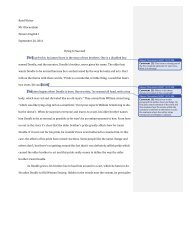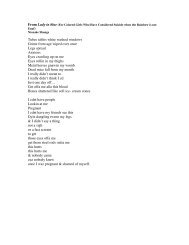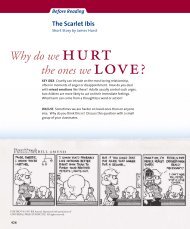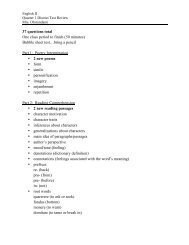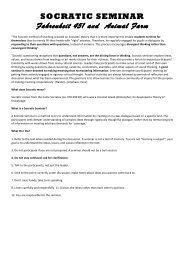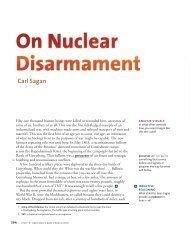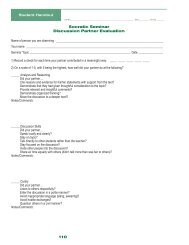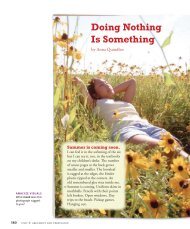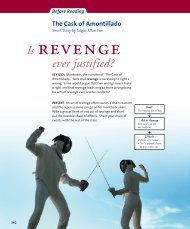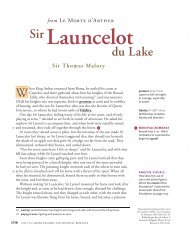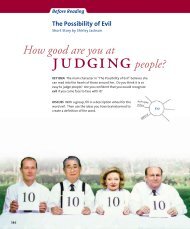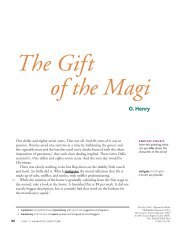The Language of Poetry - LanguageArts-NHS
The Language of Poetry - LanguageArts-NHS
The Language of Poetry - LanguageArts-NHS
Create successful ePaper yourself
Turn your PDF publications into a flip-book with our unique Google optimized e-Paper software.
Part 2: Poetic Elements<br />
What gives one poem a brisk rhythm and another the sound <strong>of</strong> an everyday<br />
conversation? How can two poems on the same subject—for example, the<br />
simplicity <strong>of</strong> nature—create dramatically different images in your mind? Sound<br />
devices and imagery are the techniques that give dimension to words on a page.<br />
sound devices<br />
Much <strong>of</strong> the power <strong>of</strong> poetry depends on rhythm—the pattern <strong>of</strong> stressed and<br />
unstressed syllables in each line. Poets use rhythm to emphasize important<br />
words or ideas and to create a mood that suits their subject. Some poems have<br />
a regular pattern <strong>of</strong> rhythm, which is called meter. Analyzing the effects <strong>of</strong> a<br />
poem’s rhythm begins with scanning, or marking, the meter. Unstressed syllables<br />
are marked with a ( ) and stressed syllables with a ( ) , as in these lines from<br />
“A Dirge” by Percy Bysshe Shelley:<br />
Rough wind, / that moan / est loud a<br />
Grief / too sad / for song; b<br />
Wild wind / when sul / len cloud a<br />
Knells / all the night / long. b<br />
A regular pattern <strong>of</strong> rhyme is called a rhyme scheme. Rhyme scheme is charted by<br />
assigning a letter <strong>of</strong> the alphabet to matching end rhymes, as shown in “A Dirge.”<br />
Poets also use many other sound devices to create specific effects. In each <strong>of</strong><br />
the following examples, notice how the device helps to establish a mood, create<br />
a rhythm, and suggest different sounds and sights <strong>of</strong> the sea.<br />
repetition<br />
a sound, word, phrase, or line that is repeated for emphasis<br />
and unity<br />
Break, break, break,<br />
On thy cold gray stones, O Sea!<br />
— from “Break, Break, Break” by Alfred, Lord Tennyson<br />
assonance<br />
the repetition <strong>of</strong> vowel sounds in words that do not end<br />
with the same consonant<br />
<strong>The</strong> waves break fold on jewelled fold.<br />
—from “Moonlight” by Sara Teasdale<br />
690 unit 7: the language <strong>of</strong> poetry<br />
alliteration<br />
the repetition <strong>of</strong> consonant sounds at the beginnings<br />
<strong>of</strong> words<br />
<strong>The</strong> scraggy rock spit shielding the town’s blue bay<br />
—from “Departure” by Sylvia Plath<br />
consonance<br />
the repetition <strong>of</strong> consonant sounds within and at the ends<br />
<strong>of</strong> words<br />
And black are the waters that sparkled so green.<br />
—from “Seal Lullaby” by Rudyard Kipling



